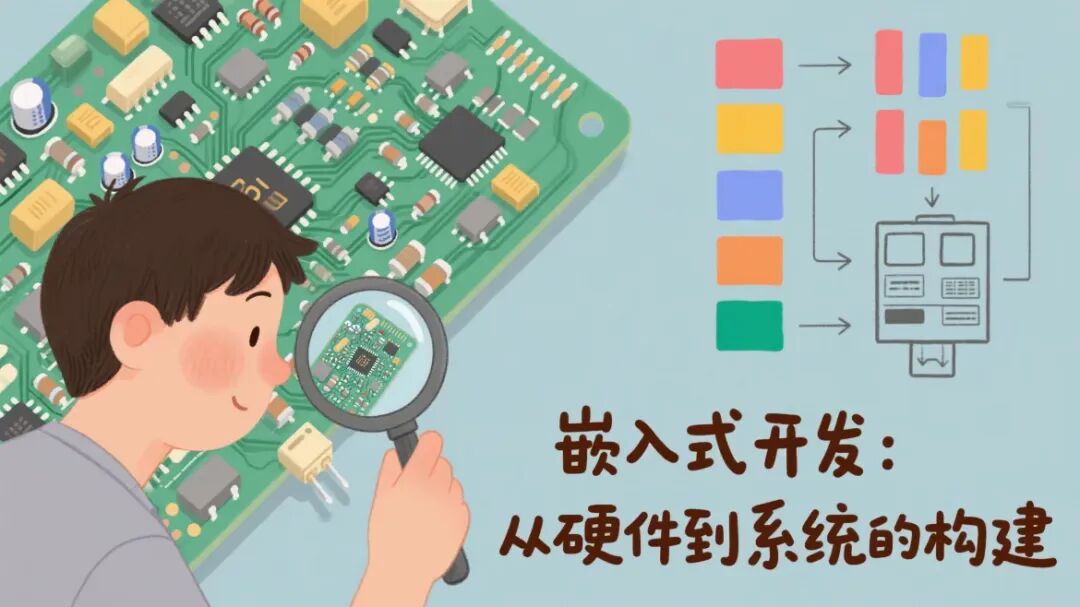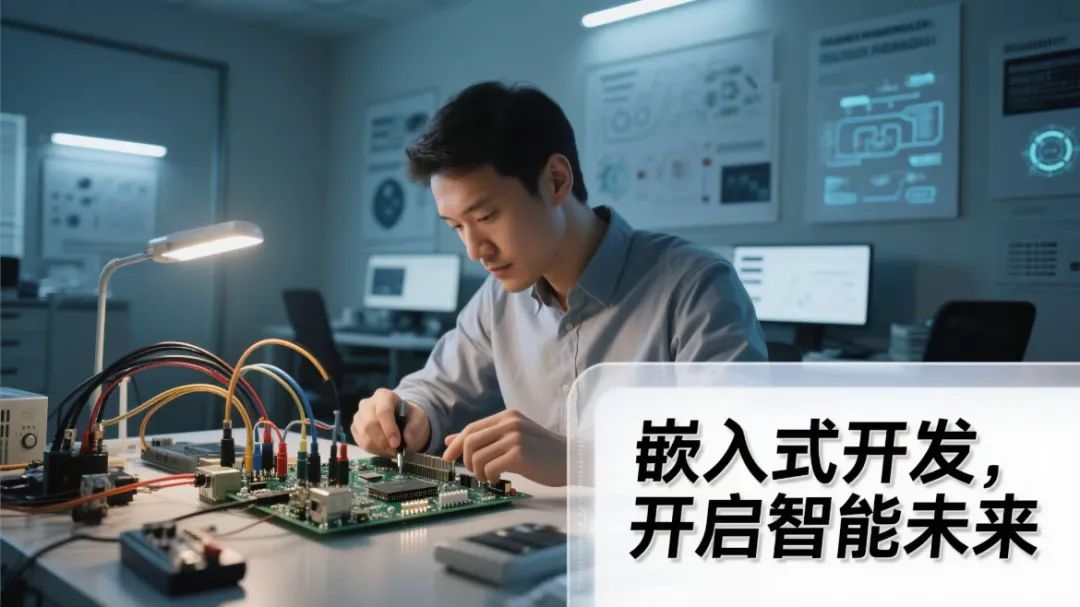In the technological wave driven by artificial intelligence and the Internet of Things, embedded development has become one of the important employment tracks in the fields of electronic information, automation, and computer science.
From precise control of smart appliances to real-time decision-making in industrial robots, from reliable communication in automotive electronics to precise monitoring in medical devices, embedded systems are deeply empowering various industries.Many students still lack a clear understanding of its technical connotations, growth paths, and career prospects. There are often students from related majors who communicate with Newton, wanting to learn embedded development but not knowing how to start.Today, Newton will comprehensively analyze embedded development, plan a clear growth path for students aspiring to enter this field, and provide practical guides from skill enhancement to career transformation. 1. Introduction to Embedded DirectionsEmbedded systems are application-centered, based on computer technology, with customizable hardware and software, suitable for dedicated computer systems with strict requirements for functionality, reliability, cost, size, and power consumption.The core characteristics are specialization (optimized for specific functions), real-time performance (quick response to external events), resource constraints (limited memory and computing power), and high reliability (long-term stable operation).Embedded development encompasses three main directions: hardware design (such as circuit boards and sensors), low-level software (drivers and operating system porting), and application layer development (algorithms and interaction logic).With the integration of technologies such as the Internet of Things and artificial intelligence, embedded systems are gradually evolving towards intelligence (edge computing), networking (5G, Wi-Fi), and multi-core heterogeneity (ARM Cortex-A/M hybrid architecture).2. Embedded Application FieldsEmbedded technology has penetrated multiple industries, with core applications including:Smart Devices: smartphones, smartwatches, AR/VR devices, and other consumer electronics.Industrial Automation: PLC controllers, industrial robots, production line monitoring systems.Automotive Electronics: in-vehicle entertainment systems, ADAS (Advanced Driver Assistance Systems), electric control units for new energy vehicles.Internet of Things (IoT): smart homes, environmental monitoring, remote medical devices.Aerospace and Military: flight control systems, radar signal processing, satellite communication devices.3. Embedded Related PositionsHardware Engineer: responsible for circuit design, PCB layout, EMC testing, and hardware reliability optimization.Embedded Software Engineer: develops drivers, ports operating systems, and applications, requiring knowledge of the Linux kernel or RTOS.Driver Development Engineer: specializes in device driver development (such as LCDs, sensors, network interfaces).System Architect: designs the overall framework of embedded systems, balancing software and hardware resource allocation.IoT Development Engineer: implements communication between devices and cloud platforms, involving protocol stack development for WiFi/Bluetooth/ZigBee.4. Basics of Embedded ProgrammingC Language Core: master pointers, structures, memory management, and bit manipulation; recommended books include “C and Pointers” and “The C Programming Language”.Data Structures and Algorithms: focus on learning linked lists, queues, stacks, and sorting algorithms, practicing memory optimization strategies in projects.Operating System Principles: understand process/thread scheduling, interrupt mechanisms, and synchronization/mutual exclusion (such as semaphores and mutexes).Assembly Language Basics: understand the ARM instruction set architecture for register-level debugging and performance optimization.Python for Auxiliary Development: used for upper computer tool development, automated testing, and scripting.5. Basics of Embedded HardwareCircuit Design:
1. Introduction to Embedded DirectionsEmbedded systems are application-centered, based on computer technology, with customizable hardware and software, suitable for dedicated computer systems with strict requirements for functionality, reliability, cost, size, and power consumption.The core characteristics are specialization (optimized for specific functions), real-time performance (quick response to external events), resource constraints (limited memory and computing power), and high reliability (long-term stable operation).Embedded development encompasses three main directions: hardware design (such as circuit boards and sensors), low-level software (drivers and operating system porting), and application layer development (algorithms and interaction logic).With the integration of technologies such as the Internet of Things and artificial intelligence, embedded systems are gradually evolving towards intelligence (edge computing), networking (5G, Wi-Fi), and multi-core heterogeneity (ARM Cortex-A/M hybrid architecture).2. Embedded Application FieldsEmbedded technology has penetrated multiple industries, with core applications including:Smart Devices: smartphones, smartwatches, AR/VR devices, and other consumer electronics.Industrial Automation: PLC controllers, industrial robots, production line monitoring systems.Automotive Electronics: in-vehicle entertainment systems, ADAS (Advanced Driver Assistance Systems), electric control units for new energy vehicles.Internet of Things (IoT): smart homes, environmental monitoring, remote medical devices.Aerospace and Military: flight control systems, radar signal processing, satellite communication devices.3. Embedded Related PositionsHardware Engineer: responsible for circuit design, PCB layout, EMC testing, and hardware reliability optimization.Embedded Software Engineer: develops drivers, ports operating systems, and applications, requiring knowledge of the Linux kernel or RTOS.Driver Development Engineer: specializes in device driver development (such as LCDs, sensors, network interfaces).System Architect: designs the overall framework of embedded systems, balancing software and hardware resource allocation.IoT Development Engineer: implements communication between devices and cloud platforms, involving protocol stack development for WiFi/Bluetooth/ZigBee.4. Basics of Embedded ProgrammingC Language Core: master pointers, structures, memory management, and bit manipulation; recommended books include “C and Pointers” and “The C Programming Language”.Data Structures and Algorithms: focus on learning linked lists, queues, stacks, and sorting algorithms, practicing memory optimization strategies in projects.Operating System Principles: understand process/thread scheduling, interrupt mechanisms, and synchronization/mutual exclusion (such as semaphores and mutexes).Assembly Language Basics: understand the ARM instruction set architecture for register-level debugging and performance optimization.Python for Auxiliary Development: used for upper computer tool development, automated testing, and scripting.5. Basics of Embedded HardwareCircuit Design:
- Analog Circuits: operational amplifier design, filtering circuits, power management modules.
- Digital Circuits: sequential logic design, bus protocols (I2C/SPI/UART).
Microprocessor Architecture: learn ARM Cortex-M/A series, RISC-V architecture, and multi-core processor scheduling mechanisms.Sensors and Actuators: master temperature/acceleration sensors, motor drives, and PWM control.Reliability Design: EMI/ESD protection, thermal design, and fault tolerance mechanisms (such as watchdog circuits).6. Embedded Development ToolsHardware Design Tools: Altium Designer (PCB design), Cadence Allegro (high-speed circuit simulation).Debugging Tools: GDB debugger, JTAG emulator, logic analyzer.Development Environment: Keil MDK (ARM development), STM32CubeMX (peripheral configuration), VSCode+PlatformIO (cross-platform development).Version Control: Git/GitLab for collaborative development, combined with CI/CD for automated builds.7. Typical Embedded PlatformsMicrocontroller Platforms: STM32 (mainstream industrial-grade MCU), ESP32 (low-power IoT solution).Embedded Linux Platforms: Raspberry Pi (teaching and prototyping), RK3588 (edge computing).Real-Time Operating System (RTOS) Platforms: FreeRTOS (lightweight task scheduling), Zephyr (scalable IoT OS).FPGA and SoC: Xilinx Zynq (hardware-software co-design), Altera Cyclone (high-speed signal processing). 8. Embedded Application Layer DevelopmentGUI Development: implement human-computer interaction interfaces based on the Qt framework, combined with OpenGL for graphics rendering.Network Communication: socket programming (TCP/UDP), MQTT/CoAP protocol stack development, and HTTP server setup.Multi-Task Development: use POSIX thread library or RTOS task API for concurrent control.Practical Projects:
8. Embedded Application Layer DevelopmentGUI Development: implement human-computer interaction interfaces based on the Qt framework, combined with OpenGL for graphics rendering.Network Communication: socket programming (TCP/UDP), MQTT/CoAP protocol stack development, and HTTP server setup.Multi-Task Development: use POSIX thread library or RTOS task API for concurrent control.Practical Projects:
- Smart Home Central Control System (integrating temperature and humidity monitoring with remote control).
- Embedded Machine Vision Application based on YOLOv8 (such as license plate recognition).
9. Embedded Low-Level DevelopmentDriver DevelopmentCharacter device drivers (LED/buttons), block device drivers (Flash storage), and network drivers (MAC layer protocols).Master device tree configuration and dynamic loading of kernel modules.System PortingU-Boot porting (bootloader customization), Linux kernel trimming, and root filesystem construction (using Buildroot/Yocto).Performance OptimizationMemory pool management to reduce fragmentation, DMA transfer to lower CPU load.Low-power design (dynamic voltage frequency adjustment, sleep mode wake-up mechanisms).10. Recommended Embedded BooksBasic Introduction“The C Programming Language”: clearly explains C language syntax, pointers, arrays, functions, and other basics.“C Primer Plus”: explains syntax, memory management, pointers, etc., through case studies, easier to read than “The C Programming Language”.“Embedded C Programming and Implementation”: discusses the application of C language in embedded systems, such as bit manipulation, interrupts, memory optimization, etc.Operating Systems and Kernels“Embedded Real-Time Operating Systems: RT-Thread Design and Implementation”: discusses RTOS multi-task management, memory allocation, interrupt handling, etc., providing practical case studies.“Linux Device Drivers”: authoritative guide covering character devices, block devices, kernel modules, etc., providing driver frameworks and debugging methods.“Understanding the Linux Kernel”: detailed analysis of core mechanisms of the Linux kernel, such as scheduling, memory management, and file systems, suitable for understanding system-level principles.Advanced Practice“The Definitive Guide to ARM Cortex-M”: details ARM Cortex-M series processor architecture, registers, peripheral interfaces, and development tools (such as STM32), providing code examples.“Complete Manual for Embedded Linux Application Development”: using S3C2410/S3C2440 development boards as examples, discusses the entire process of Linux system porting, driver development, and filesystem construction.Newton has something to say 💬Embedded development should choose hardware or software direction based on career planning; hardware focuses on circuit design and reliability, while software requires full-stack knowledge from drivers to application layers.Learning embedded development should follow the progressive path of hardware → low-level → application, consolidating knowledge through practical projects (such as smart cars, IoT gateways).Beginners can start with STM32 bare-metal development, gradually transitioning to RTOS and Linux, while focusing on deep mastery of C language and data structures.🎯 Newton recommends the learning path:Basic Stage (6-12 months): master C language, circuit basics, and STM32 microcontroller development.Advanced Stage (12-24 months): delve into RTOS/Linux kernel, driver development, and complex project practice.Expert Stage (24 months+): specialize in field technologies (such as edge computing, IoT+AI, RISC-V architecture) and participate in enterprise-level projects.👉 Click “Read More” to learn more! 👏